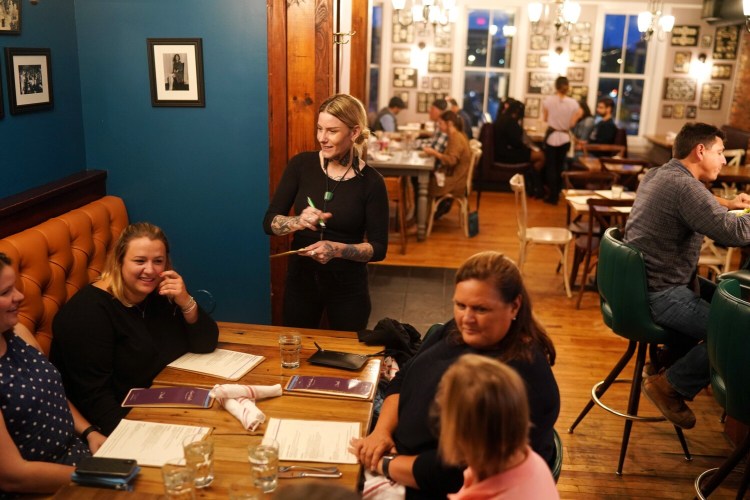Consistency might not thrill in a way that sends your pulse bounding, but that’s sort of the point. There is something powerful, almost biological about our attraction to stability. Especially when we’re in need of comfort, we crave how the reliable parts of our universe soothe us.
We feel more secure when we’re not improvising all the time, when we’re napping in our favorite pajamas, following a regular route to work or swapping stories with our oldest friends. And it’s not just humans who respond to routine: Make the same gentle, deliberate movements for a few weeks and (with enough tuna) you might slowly earn the trust of a stray cat. Our capacity for thrill-seeking gets the good press, but at our core, we are all creatures with a genetic appreciation for certainty.
Bill Leavy, co-owner and co-executive chef of East Ender understands this well. “That’s the only way to run a neighborhood restaurant, a place where people come in weekly, semi-weekly, sometimes more than that,” he said. “Consistency. It’s what we want to be known for at the end of the day. We want things for everybody to be as good as the last time they were here, and if they order a special, we want them to know it’ll be good.”
Leavy and his collaborator Karl Deuben have been striving for such steadiness since they converted Small Axe, their former food truck, into East Ender, a casual New American bistro, nearly five years ago.
No surprise then that several of the dishes on the menu are similar to those offered when our then-critic wrote a four-star review of East Ender in 2015. Perhaps the biggest changes made to the bi-level, 80-seater have been to its interior design. After a major renovation two years ago, layers of character and charm have been overlaid on its previously drowsy dining spaces – especially in the smaller downstairs room, where antique mirrors, brass chandeliers and a dark-toned paint job make the restaurant feel descended from a dreamy, nautical heritage.
The gauzy, pleasingly ersatz nostalgic sensibility is only amplified by the soundtrack of 1940s crooners piped in overhead. “This music is making me feel like grappa,” a man at a neighboring table told his date. “Frank Sinatra always makes me want a little glass of grappa after dinner.”
But our mutual server, who also said she was the bartender, wasn’t familiar with the high-octane grape distillate. First, she brought our neighbor a bottle of cassis (a syrupy blackcurrant liqueur), then, after asking, “is grappa the one that tastes like licorice?” gave up and offered a shot of Fernet Branca, describing it as “earthy and made from a root or something.” Too polite to refuse, he accepted, then pulled out his phone to look up Fernet when our server left the room. “It’s disgusting,” he whispered, wincing. “But I don’t want to offend her. I can tell she’s trying hard.”
Indeed, despite a sticky table on one recent visit, and on another, no fork and knife served with the ever-fantastic cold-smoked house cheeseburger with crisp, triple-cooked French fries ($16), service is unfailingly friendly and genuine. It may not always hit the mark, but in its imperfection, service at East Ender is perfectly consistent.
Fortunately, Deuben and Leavy’s cooking more than makes up for wobbly service.
Bistro classics shine particularly brightly, especially dishes like chicken rillettes – sort of a mayonnaise-less chicken salad of finely pulled braised thigh meat blended with its own rendered fat, along with parsley, chives and tarragon ($7) – or a crustless chocolate torte prepared pâte-à-bombe-style, its rich density generated from bubbling sugar whisked into whipped egg yolks ($9).
But East Ender’s slightly modernized dishes also impress. Everything from practically weightless gnocchi (really ricotta gnudi), sprinkled with aromatic fried sage leaves and left to luxuriate in a shallow dish of tender, savory mushroom ragu ($15), to a Caesar salad where Pecorino Romano replaces parmesan, delivering fillips of musky tang offset by a barely-set poached egg and brittle pain-de-mie croutons ($10). Deuben and Leavy also pitch-shift the source of the salad’s ample umami flavor by substituting shavings of bottarga for the most of the dressing’s anchovies.
The duo’s collective understanding of flavor even allows them to go a little off-piste, as they do in their Asian-inspired slaw, where thinly shredded red and green cabbage, toasted peanuts and sesame seeds are tossed with a tart, funky vinaigrette of soy, ginger and sesame oil ($10).

Oh that braised pork shoulder, the perfect East Ender dish for chillier days. Brianna Soukup/Staff Photographer
And while braised pork shoulder on cheesy grits ($17) may not sound terribly adventurous, East Ender’s take on the dish incorporates what Leavy describes as “our weird take on an agrodolce”: an orange glaze punched up with Sriracha. Painted onto the collapsingly tender pork and caramelized onto the cut surfaces of cipollini onions, it imparts prickles of heat and a lilting sweetness. This, more than perhaps any other dish on the menu, expresses what East Ender does best: It presents you with something hearty and familiar enough to lure you into taking a bite, then deliberately (but always gently) startles you into taking another.
Andrew Ross has written about food and dining in New York and the United Kingdom. He and his work have been featured on Martha Stewart Living Radio and in The New York Times. He is the recipient of two 2018 Critic’s Awards from the Maine Press Association.
Contact him at: andrewross.maine@gmail.com
Twitter: @AndrewRossME
Send questions/comments to the editors.


